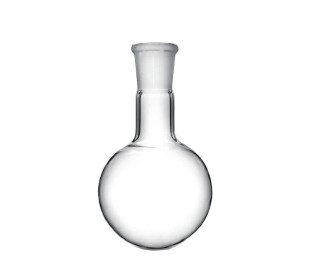Round-bottom flask with socket
Round-bottom flasks with socket sit at the heart of nearly every synthetic chemistry setup. Last week, a grad student ran a 12-hour reflux in our lab using one of these flasks—the spherical design kept the reaction mixture churning smoothly while the precision-ground socket joint held firm through constant heating cycles.
Borosilicate 3.3 glass construction handles thermal shock without cracking when you move from ice baths to heating mantles. The ground glass sockets come in standard tapers—14/20 for microscale work, 19/22 for teaching labs, and 24/29 or 29/32 for preparative synthesis. Unlike Laboratory boiling flasks designed purely for heating liquids, these vessels integrate seamlessly into complex reaction assemblies. A Flat bottom flask works fine on stirrer hotplates, but when you need rotary evaporation or Dean-Stark apparatus connections, the socket joint becomes non-negotiable.
Single-neck variants handle straightforward distillations and reflux setups. Two-neck and three-neck designs let you add reagents through one port while monitoring temperature through another. I've watched chemists run air-sensitive Grignard reactions using a three-neck round-bottom—one neck for nitrogen line, one for addition funnel, one for condenser. Compare this to a Flat Bottom Flask with socket which sits stable on benchtops but lacks the heat distribution efficiency for vigorous boiling reactions. Conical flask with a wide throat works better for culturing or simple mixing, but socket joints make modular glassware assemblies possible.
Capacities from 25ml to 5000ml cover everything from reaction optimization to pilot-scale batches. A Round bottom flask without socket costs less but forces you into cork or rubber stopper territory—fine until solvents start degrading those seals. The crystal-clear glass lets you watch precipitates form, color changes develop, and phase separations occur in real time. Heavy-wall versions withstand vacuum distillation pressures that would implode standard glassware.
Precision-Ground Joints for Advanced Synthetic Chemistry
Borosilicate 3.3 glass construction handles thermal shock without cracking when you move from ice baths to heating mantles. The ground glass sockets come in standard tapers—14/20 for microscale work, 19/22 for teaching labs, and 24/29 or 29/32 for preparative synthesis. Unlike Laboratory boiling flasks designed purely for heating liquids, these vessels integrate seamlessly into complex reaction assemblies. A Flat bottom flask works fine on stirrer hotplates, but when you need rotary evaporation or Dean-Stark apparatus connections, the socket joint becomes non-negotiable.
Multi-Neck Configuration Options
Single-neck variants handle straightforward distillations and reflux setups. Two-neck and three-neck designs let you add reagents through one port while monitoring temperature through another. I've watched chemists run air-sensitive Grignard reactions using a three-neck round-bottom—one neck for nitrogen line, one for addition funnel, one for condenser. Compare this to a Flat Bottom Flask with socket which sits stable on benchtops but lacks the heat distribution efficiency for vigorous boiling reactions. Conical flask with a wide throat works better for culturing or simple mixing, but socket joints make modular glassware assemblies possible.
Organic Synthesis Workflow Integration
- Reflux reactions: Socket connects directly to water-cooled condensers
- Rotary evaporation: Spherical shape maximizes surface area for solvent removal
- Distillation trains: Ground joints create vapor-tight seals at each connection point
- Inert atmosphere work: Sockets accept gas inlet adapters for nitrogen or argon purging
Interchangeable Component Systems
Capacities from 25ml to 5000ml cover everything from reaction optimization to pilot-scale batches. A Round bottom flask without socket costs less but forces you into cork or rubber stopper territory—fine until solvents start degrading those seals. The crystal-clear glass lets you watch precipitates form, color changes develop, and phase separations occur in real time. Heavy-wall versions withstand vacuum distillation pressures that would implode standard glassware.
Our partners
We only work with trusted brands
Sign up to our newsletter to get the latest news and updates about our products.







